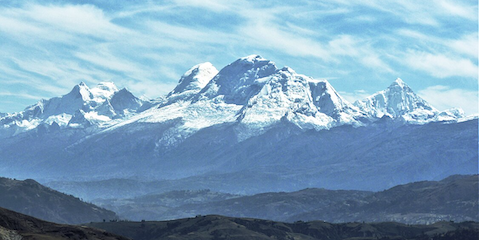
Mount Huascarán. Peru‘s tallest peak and the highest mountain in the tropical world, rising 22,205 feet (6,768 meters) above sea level in the Peruvian Andes.
Located in the Cordillera Blanca range approximately 250 kilometers northeast of Lima, Mount Huascarán serves as the centerpiece of Huascarán National Park, a UNESCO World Heritage Site designated in 1985. This majestic peak attracts mountaineers from around the globe while simultaneously representing one of the most significant natural disaster sites in South American history.
The mountain’s geological composition consists primarily of granite and metamorphic rock formations typical of the Cordillera Blanca. Mount Huascarán features two distinct summits, with the south peak being the highest point in Peru.
The mountain’s extensive glacier system feeds numerous rivers and lagoons throughout the region, making it a crucial water source for surrounding communities. The peak’s position within the tropical zone creates unique climatic conditions that support diverse ecosystems ranging from cloud forests to high-altitude puna grasslands.
Mount Huascarán gained international attention due to two catastrophic avalanche events that rank among the deadliest natural disasters in the Western Hemisphere. On January 10, 1962, an avalanche triggered by rapidly rising temperatures killed an estimated 4,000 people and destroyed nine towns and seven smaller villages. The devastation was even more severe eight years later when the May 31, 1970 earthquake triggered a debris avalanche that destroyed the town of Yungay and ten nearby villages, leaving up to 30,000 people dead. This 1970 event remains the deadliest avalanche or glacier-related disaster in recorded history.
The mountaineering significance of Mount Huascarán cannot be overstated within the global climbing community. The ascent normally takes 21 days, with the main difficulties being the large crevasses that often block the route to the summit. Professional guiding services require climbers to have previous experience above 5,500 meters (18,044 feet) before attempting this challenging peak. The mountain offers multiple technical routes, each presenting unique challenges due to changing ice conditions and weather patterns typical of high-altitude tropical glaciers.
Huascarán National Park, established in 1975, encompasses 340 hectares and protects the entire Cordillera Blanca ecosystem. The park was declared a Biosphere Reserve by UNESCO in 1977 and included in the UNESCO World Natural Heritage list in 1985. The protected area contains 25 trekking routes and 102 mountaineering spots, making it a premier destination for outdoor enthusiasts. The park also serves as habitat for endangered species including the spectacled bear, vicuña, and Andean condor.
Scientific research opportunities within Huascarán National Park span multiple disciplines. The park has potential for research in meteorology, geology, glaciology, botany, limnology, zoology, ecology, and wildlife management. Additionally, 33 archaeological sites within the park provide insights into pre-Columbian civilizations that inhabited these high-altitude regions. Climate change studies conducted on Mount Huascarán’s glaciers contribute valuable data to global warming research, as tropical glaciers serve as sensitive indicators of climate variation.
Contemporary challenges facing Mount Huascarán include the effects of climate change on its glacier systems and increasing tourism pressure. The proliferation of people and livestock, and uncontrolled exploitative tourism are degrading the quality of the site. Conservation efforts focus on sustainable tourism practices and glacier monitoring programs to protect this unique ecosystem for future generations.
Mount Huascarán remains an iconic symbol of Peru’s natural heritage, representing both the beauty and power of the Andean mountain system. Its dual legacy as a challenging mountaineering objective and site of historical tragedy ensures its continued significance in both adventure tourism and disaster preparedness studies.